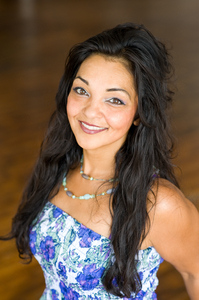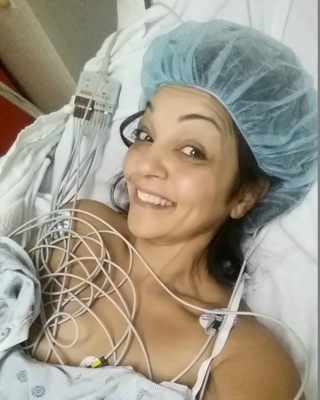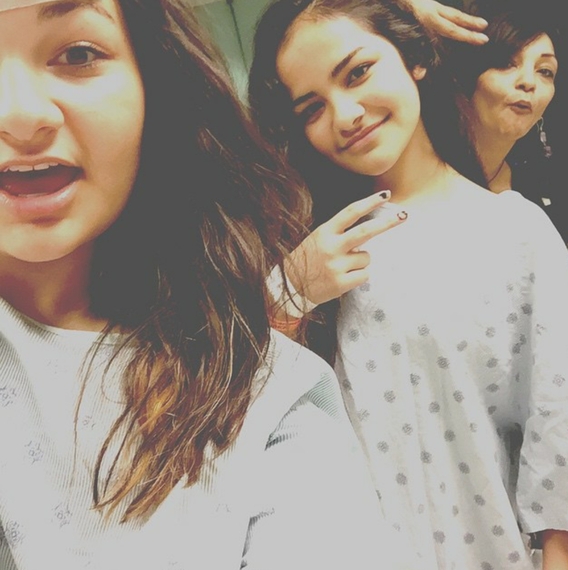 The "Funniest Mom in America" was doing her best to keep things light, looking for ways to turn a trip to the cardiologist into material for her next stand-up routine.
The "Funniest Mom in America" was doing her best to keep things light, looking for ways to turn a trip to the cardiologist into material for her next stand-up routine.
Most of all, Rubi Nicholas told herself she was only at Johns Hopkins Hospital to appease her older sister.
For more than 20 years, Rubi knew she had something called inverted T-waves. She'd been through a lot in her life without taking much care of her body, and her T-wave problem had never caused any problems.
So when her sister freaked out over being diagnosed with the same thing, Rubi cracked up. Even when that diagnosis led to the discovery that her sister had a rare, genetic heart problem -- which meant Rubi probably did, too -- she focused on reasons why she was fine.
Rubi had long since convinced herself she had "The Jungle Gene," her term for the secret of her parents' longevity. They certainly had something good in their genes: Dad grew up in a part of India where "everybody had typhoid fever," yet was approaching 80 and never got sick. Mom was among six of her mother's 16 children who survived birth; also born with a genetic resistance to malaria, she's now in her early 70s.
"I thought, `I'm going to live forever!'" Rubi said. "This was my plan. It made total sense to me."
It also was why Rubi laughed as she got her cheek swabbed at Johns Hopkins on Feb. 2. She was still thinking what a waste of time this all was when the genetic counselor started describing her risk of sudden cardiac death.
Sudden. As in, any second.
As in, you need an MRI of your heart for further analysis. And wear a heart rhythm monitor for the next week, too. And start taking beta blockers.
When she finally left the hospital, Rubi checked her phone and discovered a series of urgent messages from her sister.
The tone suggested these weren't courtesy calls to see how the appointment went.
Not at all. The news she delivered further altered Rubi's life, and the prognosis for all her loved ones.
***
Rubi grew up about 100 miles northwest of Philadelphia in the coal town of Pottsville, Pennsylvania.
Outsiders may know it as home to the Yuengling & Son, the nation's oldest brewery. To insiders, another local treasure is her father, surgeon Abdul Wahhab.
Dr. Wahhab and wife Zarina moved to the area in the early 1970s, and raised their daughters there. He is so beloved for his surgical skills and his artwork that the lobby of the hospital where he works -- which doubles as his art gallery -- is named for him.
His oldest daughter, Mina, became a plastic and reconstructive surgeon. The youngest daughter, Uzma, became a lawyer.
Rubi is the middle child. While she's earned three master's degrees and is an assistant professor of occupational therapy at a private junior college, her claim to fame comes from her second career as a stand-up comic.
In 2006, she was named "Funniest Mom in America" in a reality series on Nick at Nite. That led to appearances on the NickMom "Night Out" show, a children's book ("My Mom's Not Cool") and touring dates.
But let's back up to 1992, when Rubi was in graduate school studying to become an occupational therapist.
Part of her training was in a cardiology lab. She and her partner did electrocardiograms, or EKGs (heart rhythm tracings), on each other. The teacher looked at Rubi's results and said the students must've connected something wrong because one of her waves looked upside down. A subsequent exam showed that she'd actually done the exam correctly; the problem was she had a condition known as inverted T-waves.
At roughly the same time, Mina was out running one day when she lost consciousness and collapsed. She was in great shape, and it was dismissed as a byproduct of the stress and lifestyle of being in medical school.
As the years went on, Rubi had no cardiac issues. If anything, she had reason to believe The Jungle Gene was keeping her heart strong: Rubi routinely had more EKGs to make sure there were no side effects from medicine she took for attention deficit disorder.
Mina, meanwhile, collapsed a second time during medical school and again 12 years later. As doctors tried to trace the source, they focused on neurological issues. In August 2014, Mina collapsed a fourth time -- and, just like the three previous times, it happened when she was running. Doctors took a closer look at her heart. That is when Mina learned about her T-waves being inverted.
She called Rubi, and learned about their shared trait. Mina added: "They are testing me for ARVD. Do you know what that is?"
***
Arrhythmogenic right ventricular dysplasia, or ARVD, is marked by faulty muscle tissue in a heart's right ventricle. That tissue has actually died and been replaced with scar type tissue. This disrupts the heart's electrical signals and causes irregular heartbeats known as arrhythmias.
When you hear of young athletes who die suddenly, undetected ARVD is often the cause. In fact, ARVD is often diagnosed by coroners following a sudden cardiac arrest.
Researchers continue to seek ways to treat this condition, and I'm proud that the American Heart Association is among those leading the path to answers. The AHA has invested more than $3.7 billion into researching cardiovascular diseases, including more than $100 million annually since 1996; only the federal government spends more.
***
Mina's treatment started soon after her diagnosis. By late October, Rubi had an EKG that pretty much confirmed that she has ARVD, too.
She held out hope, though, that maybe it's a mistake. She needed to see a specialist, but for a variety of reasons won't make it to Johns Hopkins until February.
Mina heckled Rubi to speed it up. She also got her own children tests, encouraged their other sister to get tested and then worked on their extended family.
She sent an email to all their first cousins, explaining ARVD and why they were at risk. The note included about a dozen frightening bullet points meant to convey urgency.
***
Rubi went to the same doctor as Mina, which uncovered a key difference in their conditions: Rubi isn't symptomatic. She doesn't pass out. However, she is very careful to monitor anything that could lead to sudden cardiac death.
She was put in the low-to-moderate risk category. All things considered, she was OK with that.
Then came the call from Mina.
"Cousin Vaqar died today," she said. "Of sudden cardiac death."
***
Vaqar Khan was among the 11 first cousins in Albany, New York, who'd received the warning email in November.
A former Marine, he'd been working in the family cellular business and was working on opening a hamburger restaurant. He and Rubi were kindred, mischievous souls -- jokesters through and through -- which made his death even more painful. So did the fact he was only 29.
His final pathology report mentioned an electrophysiology problem with his heart. While this wasn't the same as a post-mortem ARVD diagnosis, it was close enough to hurt Rubi even more.
"If I had backed up Mina and said, `Guys, this is serious,' maybe they would've taken it more seriously," she said.
Wearing her heart rhythm monitor, Rubi joined her extended family in Albany the next day, with the funeral the morning after that. Hours later, she got a call about the MRI results; the test uncovered two irregularities, and showed that her left ventricle was working harder to compensate for the weakened right ventricle.
"We're now putting you squarely in the moderate risk category," she was told.
Hours removed from burying her cousin, her mind raced with thoughts that she was next.
And she was still wearing that darn monitor.
***
Rubi was certain that she'd be declared a high risk. The next step would be receiving an implantable cardioverter defibrillator (ICD) to regulate her heartbeat. It was agreed that Mina, the plastic surgeon, would be there to create a space for the device to go in.
But it didn't go that way.
The monitor results showed she was squarely in the moderate category. Instead of an ICD, she had another procedure in which doctors injected a medication to send her heart racing to see if it could handle it.
"That was the day they tried to break my heart," she said, "and they couldn't."
***
Rubi's daughters, 16-year-old Sophie Nicholas and 14-year-old Yasmin Nicholas, each have a genetic marker for ARVD, though that doesn't necessarily mean they have the disease or will get it. Mina's teenage children also have the genetic marker.
Some of their extended family have been tested, but not all. Rubi and Mina continue encouraging everyone who hasn't.
Rubi's ongoing treatment includes follow-ups with the heart monitor every six months, and daily doses of beta blockers. Because her ARVD, she's been told not to exert herself.
This brings up another wrinkle in her life story: a battle with weight. Only 5-foot-1, Rubi once weighed 223 pounds and wore a size 24 dress; she's now 135 and wears a size 4.
"This fat girl never has to exercise again!" she said, laughing. "I've even got a note from a doctor at Johns Hopkins saying so!"
(Full disclosure: She's maintaining her weight other ways, as doctors say remaining below 139 pounds is key to keeping a healthy "cardiac load," which would lower her risk of sudden cardiac death. Anything higher than 139 has to be checked out because it could be a sign of fluid retention.)
Humor obviously is a great tonic. She's incorporated several elements of her ordeal into her act.
"For me, it's a defense mechanism," she said. "I'm taking an awful day and making it funny.
"I look at it and think, `How can I laugh about it?'"
Beta blockers and laughter. For the "Funniest Mom in America," that's a pretty good regimen these days.


